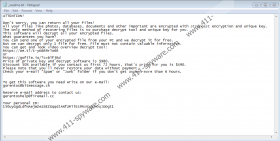Seto Ransomware Removal Guide
Did Seto Ransomware encrypt your personal documents and other files? It if did, you might be looking into third-party decryptors or maybe even the decryptor offered by the same people who attacked your operating system in the first place. Well, unfortunately, ransomware infections are, in most cases, instruments of virtual scheming, and even though the attackers might promise tools, keys, and services, these promises are likely to dissipate the moment that the ransom is received. The infection is classified as “ransomware” because once files are encrypted, a message is delivered suggesting that the victim has to pay money to obtain a decryptor. Needless to say, our research team does NOT recommend paying the ransom, but, ultimately, it is all up to you. If you want more information about the infection, continue reading the report, but do not waste too much time because you need to perform removal. The sooner you delete Seto Ransomware, the better.
If you have discovered Seto Ransomware, it is most likely that you have downloaded something new from an unreliable source, opened a file attached to a misleading email, or left remote access to your operating system exposed. Carelessness and inability to protect operating systems is what leads to the invasion of malware. That is also how your system could be attacked by Kvag Ransomware, Zatrov Ransomware, Moka Ransomware, and other infections from the STOP Ransomware family. Moreover, there are plenty of other ransomware families and other kinds of malicious threats in general that could try to slither in through the security backdoors that are left wide open. Although there are plenty of threats that are even more dangerous than ransomware, file-encryptors are terrible because they usually cause a total loss of personal files. When Seto Ransomware attacks, it adds the “.seto” extension to make it easier for you to spot which files were encrypted. Unfortunately, you cannot restore the files by removing this extension or by removing the infection itself.
In the local drive, you should find a file named “_readme.txt.” This file informs that your files can be restored if you follow the instructions. They include sending a unique ID code to the attackers (the email addresses are gorentos@bitmessage.ch and gerentoshelp@firemail.cc) and then paying a huge ransom. The full cost is $980, but you are informed that a special discount is available for you if you pay the ransom within 72 hours. Even though $490 slashes the full cost in half, it is still a lot of money for something that you are unlikely to get anyway. It appears that malware researchers have come up with a legitimate decryptor that can restore files if they were encrypted with an offline key. Needless to say, if you do not have backups that could replace the encrypted files, and if you cannot bear the thought of losing your files, you might choose to take the risk of paying the ransom. Well, before you do that, try out a legitimate decryptor. Even if it does not work for you, you want to exhaust all options before you even think about contacting the attackers. Since it is extremely risky, we do not recommend it.
Those who are able to identify the launcher of the devious infection should have no trouble deleting it manually. Once you remove Seto Ransomware launcher, all you need to do is erase the remaining components, which should not be hard to find. Of course, manual removal is never the ideal option when it comes to malware of any kind. Mistakes can be made, and components can be left behind, and so if you want to guarantee that you have Seto Ransomware deleted, we suggest installing anti-malware software. It will automatically clear your entire operating system and, at the same time, will reinstate full protection. If your system is protected reliably, your chances of facing new infections will be minimized. If you also act more carefully when downloading new files, opening email attachments, or operating remote access systems, you should be able to evade malware altogether.
How to delete Seto Ransomware
- If you can identify the infection’s launcher, immediately Delete it.
- Simultaneously tap Win+E to launch Windows Explorer.
- Type %HOMEDRIVE% into the bar at the top and tap Enter.
- Delete the ransom note file named _readme.txt.
- Delete the folder named SystemID with the PersonalID.txt file inside.
- Type %LOCALAPPDATA% into the bar at the top and tap Enter.
- Delete the folder that contains ransomware files. The name is random.
- To complete removal, Empty Recycle Bin.
- Install a malware scanner you can trust.
- Perform a full system scan to check for leftovers.
Seto Ransomware Screenshots:


